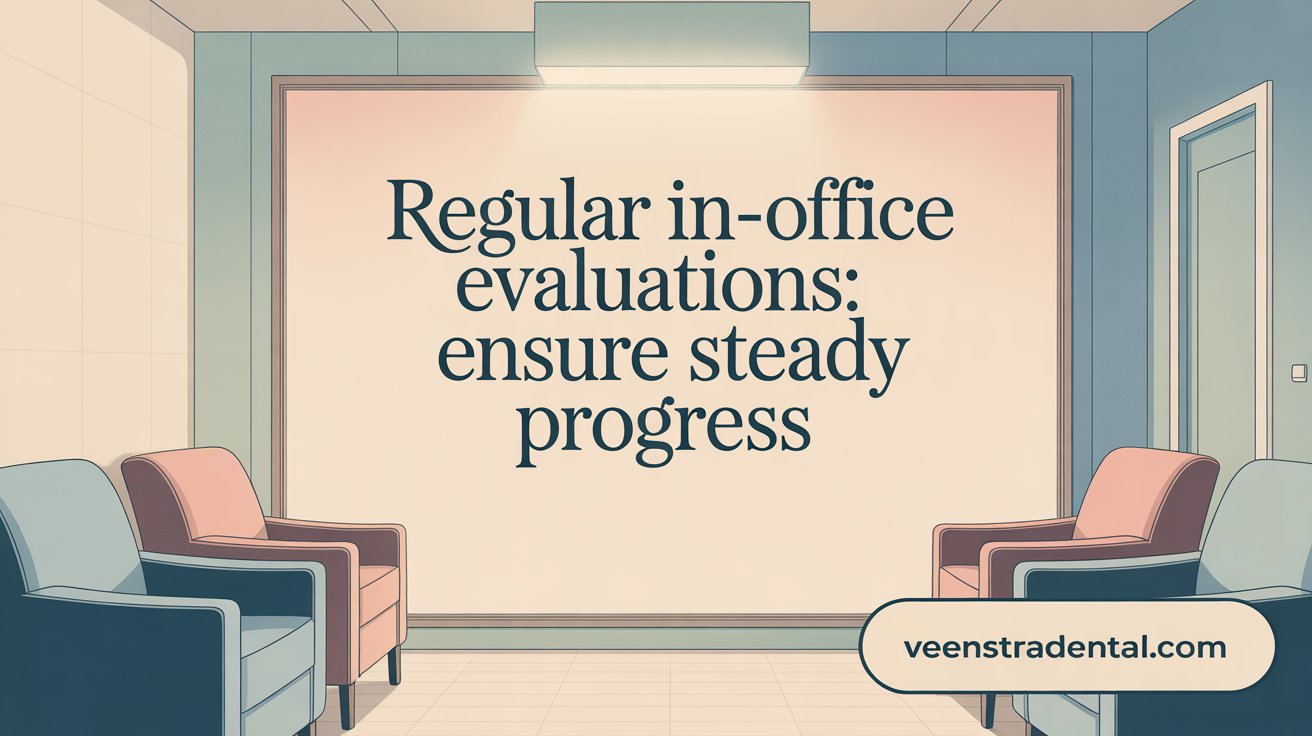Understanding Clear Aligner Treatment and Its Monitoring
Clear aligner therapy is a transformative dental procedure that gradually shifts teeth into their ideal positions using a series of custom-made, transparent trays. To ensure the best results, continuous monitoring of treatment progress from start to finish is essential. This article explores how aligner therapy is tracked through advanced technologies, professional check-ups, and patient self-monitoring, providing insight into key milestones and how patients can actively participate in their journey toward a perfect smile.
The Foundation: Initial Assessment and Treatment Planning

Initial consultation and detailed examination
The Invisalign journey begins with a comprehensive initial consultation. During this visit, the orthodontist performs a detailed examination of the patient's teeth and oral health. This includes taking photographs, x-rays, and digital impressions to create a complete picture of the current dental situation.
Role of digital impressions and 3D scans
Modern digital technology plays a crucial role in planning treatment. Digital impressions and 3D scans capture precise images of the teeth and gums. These digital models allow orthodontists to analyze the current alignment and plan tooth movements with high accuracy.
Development of personalized treatment plans with Invisalign software
Using specialized Invisalign software, orthodontists develop a customized treatment plan. The software maps out the step-by-step movement of teeth from their current position to the desired final alignment. This 3D visualization helps both the doctor and patient understand the treatment process and expected results.
Custom fabrication of clear aligners based on precise digital models
Based on the digital impressions and treatment plan, custom clear aligners are fabricated. Each set of aligners is precisely designed to fit the patient's teeth and exert controlled pressure to guide teeth into the desired positions gradually. The accuracy of digital modeling ensures that each aligner fits well and moves teeth effectively, setting the foundation for a smooth and successful orthodontic journey.
Tools and Techniques for Monitoring Aligner Progress

How do you track progress during Invisalign treatment?
Monitoring the progress of Invisalign treatment involves a combination of visual assessments, digital imaging, and remote tools. Patients can perform simple at-home checks by visually inspecting their teeth for alignment improvements, fit of the aligners, and tracking tooth movement over time. Regular visual inspection helps identify issues like gaps, looseness, or discomfort.
In-office, orthodontists utilize advanced digital scans and 3D imaging technologies such as intraoral scanners to compare current tooth positions with the original treatment plan. These detailed images enable precise evaluation of how well the teeth are moving and whether adjustments are necessary.
Remote monitoring has become increasingly popular. Patients regularly take high-quality photos of their teeth using the Invisalign Practice app or My Invisalign mobile app. These images are uploaded for review by the orthodontist through secure platforms like Virtual Care AI. The doctor assesses progress remotely, providing feedback and advice without the need for frequent office visits.
Additionally, digital tools like SmileView™ offer simulated previews of treatment progress, helping patients visualize their expected improvements. Treatment calendars and aligner time logs assist in tracking wear compliance, ensuring the plan stays on schedule.
This combined approach of visual, digital, and remote assessments ensures that Invisalign treatment progresses smoothly, allowing timely interventions when needed.
Self-Monitoring and Routine Maintenance: Empowering Patients

How can patients visually monitor their aligner treatment progress at home?
Patients can keep track of their progress by taking consistent weekly photos of their teeth. Using good lighting and the same angles for each shot helps accurately observe subtle changes over time. These visual updates provide a clear picture of how well the treatment is progressing.
Along with photo tracking, maintaining adherence to the schedule is vital. Most treatment plans recommend changing aligners every 1-2 weeks. Paying attention to how teeth feel during these changes can offer additional clues; slight discomfort or pressure is normal, but persistent or severe pain might indicate an issue requiring consultation.
In addition to visual checks, patients should ensure they wear their aligners for the prescribed 20-22 hours daily. Using reminders, timers, and app-based trackers can help establish consistent wear routines, preventing delays in progress.
Regular visits to the orthodontist are also important. During these check-ups, professionals evaluate actual tooth movement, fit of aligners, and make necessary adjustments. Addressing concerns early, whether discomfort, fit issues, or unexpected changes, helps keep treatment on track.
Furthermore, maintaining strong oral hygiene—brushing, flossing, and cleaning aligners regularly—supports healthy teeth and optimizes results. Overall, combining regular self-assessments with professional monitoring ensures effective and steady progress throughout aligner treatment.
Professional Check-Ups: Ensuring Effective and Timely Adjustments
 Regular in-office check-ups at intervals of 6 to 8 weeks are vital for tracking the progress of clear aligner treatment. During these visits, the orthodontist thoroughly assesses how well the teeth are moving and whether the aligners continue to fit properly. They utilize updated 3D scans to compare the current positions of the teeth against the original treatment plan. This comparison helps identify any discrepancies or delays in progress.
Regular in-office check-ups at intervals of 6 to 8 weeks are vital for tracking the progress of clear aligner treatment. During these visits, the orthodontist thoroughly assesses how well the teeth are moving and whether the aligners continue to fit properly. They utilize updated 3D scans to compare the current positions of the teeth against the original treatment plan. This comparison helps identify any discrepancies or delays in progress.
Patient feedback plays a significant role during these appointments. If discomfort, looseness, or other issues are reported, the orthodontist can address these promptly. Common adjustments include refining the treatment plan, creating new aligners, or making modifications to enhance fit and effectiveness.
Mid-treatment evaluations allow orthodontists to verify that teeth are progressing as expected, and final assessments confirm that the desired alignment has been achieved. Post-treatment care involves fitting retainers to maintain results, along with guidance on their use and ongoing oral hygiene maintenance.
Overall, these scheduled check-ups are crucial for ensuring treatment stays on track, addressing concerns early, and optimizing outcomes for a confident, healthy smile.
Recognizing Key Signs and Milestones Indicating Proper Progression
 Monitoring progress during Invisalign or similar clear aligner treatments involves observing several tangible signs and milestones that reflect effective teeth movement.
Monitoring progress during Invisalign or similar clear aligner treatments involves observing several tangible signs and milestones that reflect effective teeth movement.
One of the most visible indicators is the gradual improvement in teeth alignment. Patients might notice gaps closing, spaces decreasing, and misaligned teeth becoming straighter over time. These changes can often be documented through regular photos or visual checks. Additionally, as teeth move into their new positions, aligners tend to fit slightly looser than at the start, which is a normal and positive sign that the planned adjustments are occurring.
Regular professional check-ups, typically scheduled every six to eight weeks, are essential for an orthodontist to assess whether the teeth are progressing as intended. During these visits, the orthodontist examines the fit of the aligners, compares current tooth positions with digital treatment plans, and makes any necessary adjustments, such as providing new aligners or refining existing ones. Patients can aid this monitoring process by tracking their progress with digital tools or photos, which can serve as visual evidence of movement.
Signs like persistent gaps between teeth and aligners, lingering discomfort beyond the initial days of a new aligner, or loose fit that indicates teeth are shifting properly, should all be reported to the orthodontist early. These signals help ensure that any issues are addressed promptly to keep treatment on track.
Celebrating early milestones—such as successfully closing gaps or achieving a more aligned look—can motivate patients and boost confidence in the process. Recognizing these achievements supports continued commitment to wearing aligners consistently.
The importance of adhering to the recommended schedule of 20-22 hours of wear daily cannot be overstated. Consistent use allows steady pressure on teeth, moving them effectively along the treatment plan. Irregular wear can lead to delays, discomfort, or incomplete movements, ultimately extending the duration of treatment.
By observing these signs and maintaining consistent wear and regular check-ups, patients can be assured that their treatment is progressing properly, eventually leading to a confident and healthy smile.
Ensuring Successful Outcomes Through Consistent Monitoring
Effective clear aligner treatment is a dynamic process that requires collaboration between orthodontists and patients. Through advanced digital imaging, regular professional check-ups, and proactive self-monitoring, patients can stay informed about their progress and address any challenges early. Understanding key signs of proper alignment and maintaining diligent wear time empower patients to achieve their desired smile efficiently and comfortably. With comprehensive progress tracking from start to finish, clear aligners become a reliable and convenient solution for transforming smiles with confidence and care.
References
- How to Monitor Progress with Clear Aligners | Hemphill Orthodontics
- How Do You Monitor Progress While Using Clear Aligner Trays?
- Tracking Progress with Clear Aligners - Ollins Orthodontics
- Monitoring Progress with Clear Aligners | Innovative Orthodontics
- How Do You Monitor Progress While Using Clear Aligner Trays?
- Unlocking the Secret to Tracking Progress with Invisalign in Norfolk
- Invisalign Progress: Tracking Your Smile Journey - Nova Orthodontics
- 5 Signs Your Invisalign Are Tracking - Valley Creek Dental Care
